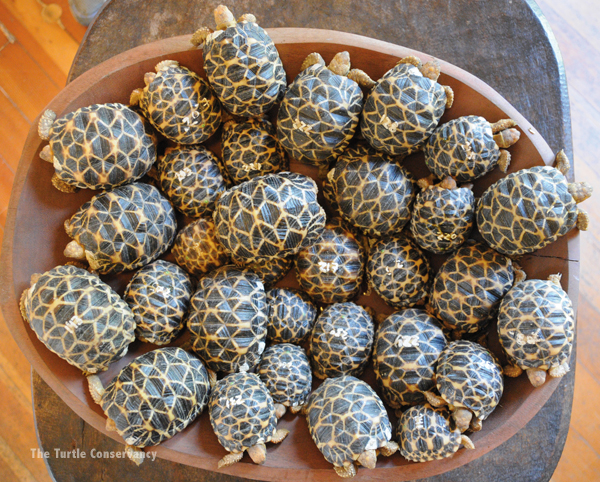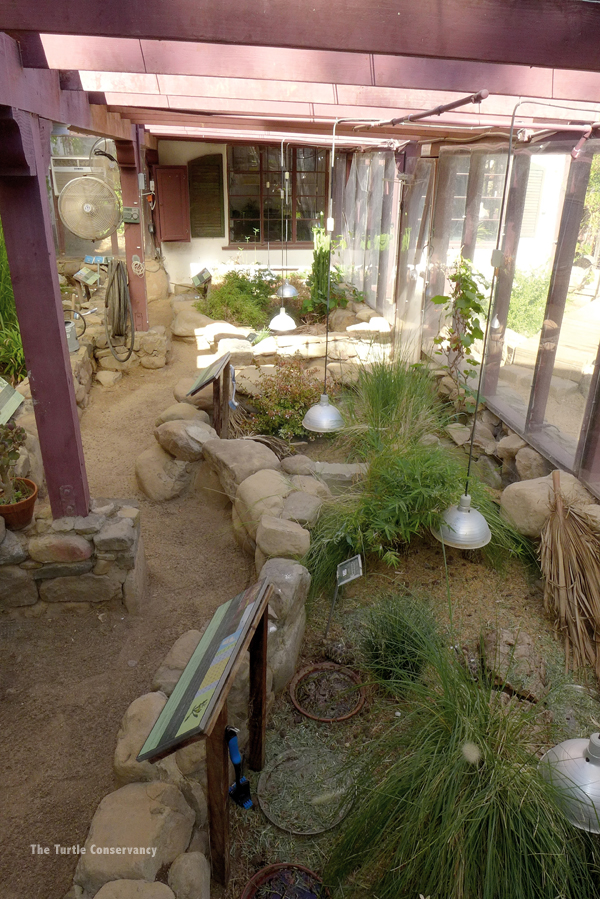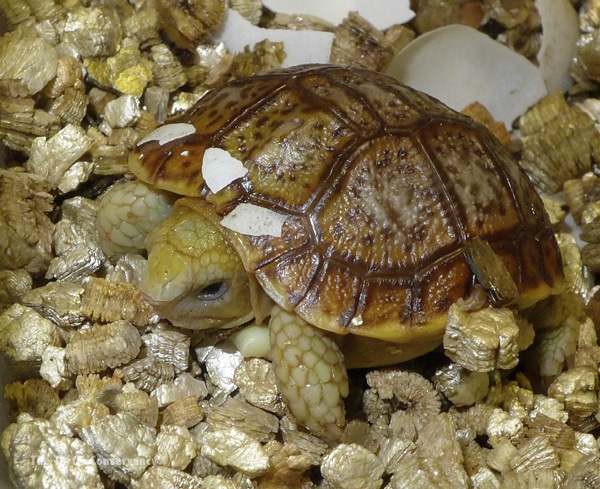In 2004, John L. Behler (1943-2006), then curator of reptiles at the Bronx Zoo in New York City, sought out conservationist Eric Goode to ask whether
In 2004, John L. Behler (1943-2006), then curator of reptiles at the Bronx Zoo in New York City, sought out conservationist Eric Goode to ask whether he would be willing to provide a permanent home for the zoo’s long-standing collection of endangered tortoises being kept at St. Catherine’s Island in Georgia. Goode, a lifetime turtle enthusiast, rose to the challenge and transformed his Southern California retreat into The Turtle Conservancy, a non-profit facility certified by the Association of Zoos and Aquariums (AZA) and dedicated to protecting the most endangered turtles and tortoises and their habitats worldwide. In 2006, we named the new campus “The Behler Chelonian Center” to honor John’s life of dedicated service to turtle and tortoise conservation.

the turtle conservancy
Shade-loving species, such as the forest hinge-backed tortoise, reside beneath these specially designed tables that house both juveniles and hatchling tortoises.
Since that time, The Turtle Conservancy has become one of the most successful conservation-breeding centers in the world. We have hatched over 1,300 offspring from 20 different species, 99 percent of which are threatened with extinction, according to the Tortoise and Freshwater Turtle Specialist Group of the IUCN. Eighteen of the 44 species we have cared for over the years are critically endangered, 13 are endangered and two are vulnerable. Experienced turtle keepers would agree that several of these species are difficult to keep alive, let alone breed in captivity. Examples include the impressed tortoise (Manouria impressa), forest hinge-back tortoise (Kinixys erosa), Chaco tortoise (Chelonoidis chilensis), Okinawa leaf turtle (Geoemyda japonica), Madagascar flat-tailed tortoise (Pyxis planicauda) and all three subspecies of spider tortoise (Pyxis arachnoides). Such delicate species require a peaceful existence with minimal human contact to thrive, and we can focus on husbandry at The Turtle Conservancy, instead of attendance and entertainment like most zoos, because we are not open to the public.
Keep Captive-Bred Animals
The Turtle Conservancy takes its mission seriously, protecting species from the threats that drive them toward extinction. Our animals come from other zoological institutions, wildlife authorities that have confiscated illegally trafficked animals around the world, and from private individuals who donate their animals for conservation. Our policy is to not buy wild-caught animals; therefore, we do not contribute to one of the greatest threats to endangered turtles and tortoises. We strongly encourage hobbyists and pet owners to demand captive-bred reptiles instead of supporting the global wildlife trade.
The number of pet turtles in the United States is growing, and commercial trade in wild-caught reptiles is one of the factors driving many species toward extinction.
Read More
The Endangered Forsten’s Tortoise
Chelonians: Wild Caught Or Captive Bred?

Turtle Conservancy
The Turtle Conservancy takes its mission seriously, protecting species from the threats that drive them toward extinction.
Alternatively, when you choose to purchase captive-born reptiles from local or regional breeders instead of buying wild-caught animals, you not only reduce pressure on wild populations, but if you breed them, you might help prevent their extinction. The African spurred tortoise (Centrochelys sulcata) is just one example of how an endangered species can become one of the most common pet reptiles and be at lower risk of extinction because of the work of hobbyists and private breeders. Many other species might also be helped in this way, and The Turtle Conservancy is setting an example for the zoological community by offering a limited number of our captive-bred offspring to qualified private individuals for this very reason. All proceeds from these adoptions directly support our in-range global conservation programs. Together, we can ensure these species live on.
International Conservation
The offspring we hatch at The Turtle Conservancy participate in programs that help save their species from extinction. Accordingly, the best possible outcome is to repatriate our captive-born offspring to their native habitats. This is more difficult than one might imagine, and amazingly, with the five yearling golden coin turtles (Cuora trifasciata) we sent to Hong Kong for a reintroduction program in January 2013, The Turtle Conservancy became the first organization to return foreign-born, captive-bred turtles to their native country for conservation.

The Turtle Conservancy
More Burmese star tortoises are hatched at The Turtle Conservancy than at any other breeding facility outside of Myanmar.
We also share offspring with other conservation centers to create multiple assurance colonies around the world, providing a safety net in case of natural disasters, political uprisings or insufficient funding. For example, in May 2014 we sent Burmese star (Geochelone platynota) and Burmese black mountain tortoises (Manouria emys phayrei) to initiate colonies at Richard Branson’s conservation center on Necker Island in the British Virgin Islands. In addition to these programs, a few of our offspring will remain in AZA institutions to satisfy the needs of their Species Survival Plan programs and ensure genetic variability in the professionally managed captive populations.

the turtle conservancy
Keeper Juan Hernandez.
The Turtle Conservancy’s in-country conservation programs include habitat protection and stewardship, turtle and tortoise reintroduction and education, curbing the illegal wildlife trade, and a seed grant program. Our work currently spans the globe and includes 14 countries. For example, we are preserving one of the last strongholds of the critically endangered geometric tortoise (Psammobates geometricus) in South Africa, and we work with partners to protect the critically endangered ploughshare tortoise (Astrochelys yniphora) in Madagascar by engaging in community education programs and by marking the shells of wild tortoises with an indelible inscription to thwart poachers.
On-Site Greenhouses
The Turtle Conservancy’s formula for husbandry success relies heavily on knowledge about each species’ unique natural history. We personally undertake field expeditions to the native range of species under our care to fill in the gaps in available scientific evidence regarding seasonal and daily variations in temperature, humidity, rainfall, fog, water sources, canopy, diet, shelter, substrates and activity. At our conservation-breeding center, we continually define and redefine the best possible husbandry techniques to provide species-specific microhabitat needs with a limited number of indoor environments and the Mediterranean climate of California’s central coast. We provide as much outdoor time as possible with fresh air, sunshine and natural browse. Although we avoid mixing multiple species in a single enclosure, we do group species from similar climates together in the same building.

The turtle conservancy
Senior Keeper Armando Jimenez holds a large male impressed tortoise inside the “cloud forest” greenhouse.
We have two greenhouses that provide their occupants with excellent exposure to natural light cycles, but which can be challenging to heat and cool. One simulates a cloud forest and is kept very humid with moderate temperatures (84 degrees Fahrenheit during the day, 72 degrees at night), and the other simulates a lowland hot climate with moderate humidity and a broad diurnal temperature fluctuation (90 degrees day/68 degrees night). Both employ multiple heating, cooling and moisture systems coordinated by an advanced climate control computer manufactured for commercial greenhouses.
The cloud forest environment primarily houses impressed tortoises and Okinawa leaf turtles. The hot lowland environment houses an array of species, including Sulawesi forest turtles (Leucocephalon yuwonoi), Forsten’s tortoises (Indotestudo forstenii), spiny hill turtles (Heosemys spinosa), Arakan forest turtles (Heosemys depressa), Oaxaca wood turtles (Rhinoclemmys rubida rubida) and Burmese star tortoises, which spend much of their time outdoors.
Background heating systems include circulating warm water in the concrete floor and hot water radiators on the walls. Automated ridge vents open with cooling needs, and when temperatures really heat up, they close almost completely so fresh cool air can freely enter from the air conditioner in the cloud forest greenhouse or the commercial evaporative cooler in the lowland hot greenhouse. Horizontal shade-cloth curtains draw closed to reduce excess radiant heat on sunny days and at night to hold warmth inside. Humidity is maintained with commercial ultrasonic and centrifugal humidifiers.

The turtle conservancy
Pan’s box turtles are housed in this outdoor enclosure year-round. The turtles hibernate on the bottom of the pool or buried in leaf litter on land.
We provide locally high humidity, condensation and artificial rain inside enclosures using irrigation or fine-mist systems to meet species-specific needs. Basking spots are provided using ultraviolet-B (UVB)-emitting mercury vapor lamps on cloudy days and in enclosures with insufficient sunlight. Some of the greenhouse panels are Acrylite OP-4 acrylic, which transmits some UVB radiation, and others are either Plexiglas or tempered glass, which both block nearly all UVB. We provide compact fluorescent UVB-emitting bulbs for non-basking species that are generally more active at dusk and for those from dense forests with little direct sunlight. Lights are timed to meet the individual needs of each species, including seasonality and basking behavior. The intensity of UVB emitted by each lamp is tested every six months using a meter with peak response at 290 nm, and lamps are replaced when UVB emission falls below 10 microWatts/cm2 at the basking site.
Other Optimal Environments
In addition to the greenhouses, we constructed two semi-enclosed environments that we call “cold frames,” with removable translucent panels that constrain temperature extremes and manage humidity. The first of these simulates coastal dry zones with 90-percent relative humidity at night and 20 percent during the day. Species housed here include the Egyptian tortoise (Testudo kleinmanni), spider tortoise (Pyxis arachnoides) and ploughshare tortoise, which all retreat beneath shrubs or bushes at night and during the hot, dry hours of the day to take advantage of focal moderate humidity.
The second “cold frame” simulates southern hemisphere scrub habitats with generally cooler temperatures and low to moderate humidity. The species housed here include Chaco tortoises (Chelonoidis chilensis), parrot-beaked tortoises (Homopus areolatus) and angulated tortoises (Chersina angulata), which all retreat into subterranean burrows at night and during the heat of the day to find moderate humidity and temperature.

The turtle conservancy
This semi-enclosed “cold frame” houses Egyptian and ploughshare tortoises.
We also utilize two well-heated, well-insulated and biologically isolated houses to provide safe environments for hatchlings, animals under quarantine and the most temperature-sensitive species during the winter. These houses employ insulated wood-frame construction with screened windows and skylights that provide natural ambient light cycles and insect-proof ventilation.
In addition, there are four large tortoise houses for hardy species such as radiated tortoises (Astrochelys radiata) and Galapagos tortoises (Chelonoidis nigra complex). Circulating warm water in the floors and radiators is used for background heating, and basking sites are illuminated as needed. Materials and instruments such as pens, notebooks, scales, hoses, nozzles, scrub-brushes, tools, mops, buckets and watering cans are dedicated to each house, and footbaths are used at all entrances and exits. Disposable, biodegradable nitrile gloves are used on individual enclosures, not just in these houses but throughout the center as part of The Turtle Conservancy’s comprehensive biosecurity plan.
Ponds, pools and aquariums are managed with recirculating biological filtration with UVB sterilizers in the larger systems. One pond is approximately 40 inches deep and allows for outdoor hibernation of Pan’s box turtle (Cuora pani). We monitor water quality parameters with a multi-test kit and perform partial water changes as often as twice a week in systems with numerous turtles.
The Casitas
Twelve small houses called “casitas” provide hardy outdoor species, such as radiated tortoises and Burmese black mountain tortoises, with a warm, dry space on cool nights and during brief periods of winter rain. These small houses are approximately 4 feet long, 3 feet wide and 30 inches tall. They are insulated with R-10 rigid foam insulation beneath the concrete slab and between layers of plywood on the walls, top and doors. Cracks are sealed with weather-stripping to prevent drafts, heat is provided by thermostat-controlled ceramic heat emitters, and daytime light is provided by timer-controlled compact fluorescent bulbs. Interior height is designed so electrical fixtures are high enough to protect the tortoises from thermal burns.
Bedding in the casitas consists of grass hay and rice hulls for radiated tortoises, and sphagnum moss for Burmese black mountain tortoises. We open casita doors in the morning and encourage the tortoises to exit the houses within a few hours. Flexible, translucent vinyl door strips are hung inside the doorframes to retain heat when a door is open on relatively cool days, and most tortoises pass through them readily.
Hatchlings and Juveniles
Six floor-to-ceiling incubators provide enough space for more than 500 eggs at one time. We incubate 130 to 150 clutches and hatch out 250 to 300 turtles and tortoises per year. Each incubator is set for temperatures that meet the needs of the species being incubated. High-temperature incubators (85 to 90 degrees) have a thermostat that allows them to cool down to 75 to 78 degrees at night, which simulates the daily fluctuations found in natural nests. Incubators for forest and temperate species are kept at relatively cooler temperatures (78 to 82 degrees) without daily fluctuations because the microhabitats in these regions have more constant diurnal temperatures.

the turtle conservancy
The Turtle Conservancy is one of only a few facilities around the world to breed impressed tortoises.
Incubation protocols are based on the natural history of each individual species. Over time we refine them according to our successes and failures. For example, we started incubating parrot-beaked tortoise eggs in their natural nest in the substrate of the enclosure, and we hatched two of six eggs. Then we incubated the next eight eggs in an incubator at either 82 or 86 degrees because other people reported success at those temperatures, but none hatched. With that new knowledge, we began incubating at 89 degrees, and since then have hatched five out of five parrot-beaked tortoise eggs. The next step is to define what temperatures produce each sex.

The turtle conservancy
Collection Manager Christine Light weighs and measures a new hatchling parrot-beaked tortoise.
We house juvenile tortoises in tables constructed from common lumber. A table approximately 28 inches wide and 60 inches long can accommodate up to 30 hatchling tortoises with plates, dishes, plants and dÈcor for hiding, browsing and environmental enrichment. We drill holes in the bottom for drainage and paint interior surfaces with floor epoxy to delay moisture damage. A hinged top of hardware cloth excludes predators, especially rats.
A table depth of 14 inches can accommodate a few inches of gravel, a layer of weed cloth and sufficient topsoil substrate for plants to root and tortoises to dig. We also provide a layer of rice hulls mixed with sand to allow juvenile Burmese star tortoises and spider tortoises to bury themselves. At night we cover outdoor tables with thermostat-controlled heating pads and insulated blankets whenever temperatures are predicted to be less than 65 degrees. We water the plants once or twice a week, and use a fine mist to cool and moisturize the air on very hot, dry days. We strategically place palm fronds to provide additional patches of shade on sunny days when ambient temperatures exceed 90 degrees because the substrate in direct sunlight can reach in excess of 140 degrees.
Keeping records is a major part of managing such a large collection. Each specimen is photographed regularly because individual markings change with age. No identification system is perfect, so at The Turtle Conservancy we use redundant systems including radio frequency identification (aka PIT tags), marginal marks, color coding and painted numbers. Information is recorded in the International Species Information System database using the online software known as “Zoological Information Management System.” Each species is managed to meet reproductive and demographic needs of its conservation programs. Thefts have occurred at conservation breeding centers around the world, so we maintain a multi-layered security system including infrared motion detectors and video cameras with 24/7/365 monitoring.
You Can Help
The Turtle Conservancy’s work protecting species from extinction can only be sustained through generous public support, and even small donations help feed the animals and keep them healthy. Our goals are not just to be a last line of defense against extinction, like Noah’s Ark, but also to actively refine husbandry techniques, enhance reproduction and protect native habitats to ensure that wild populations are self sustaining.
What can you do to help? First, know the laws and report illegal animal trafficking activities to the authorities, especially the U.S. Fish and Wildlife Service. Second, buy reptiles that were captive-born in your region at facilities such as The Turtle Conservancy. Third, volunteer with local, regional and international programs that help protect species from extinction. And fourth, donate generously to organizations that protect threatened species.
Learn more about our work at TurtleConservancy.org and follow us on Twitter @turtletweets.
Paul Gibbons, DVM, MS, DABVP (Reptiles/Amphibians) is the managing director of The Turtle Conservancy’s conservation breeding program. Eric Goode is the founder and president of The Turtle Conservancy. Both travel the globe studying endangered turtles in their native habitats and protecting them from extinction.
The Okinawa leaf turtle is considered a national treasure in Japan.
The Sulawesi forest turtle is another critically endangered species
that is maintained
at The Turtle
Conservancy.
Six incubators provide space for 500 eggs at a time, allowing The Turtle Conservancy to hatch up to 300 turtles and tortoises each year.
More Burmese star tortoises are hatched at The Turtle Conservancy than at any other breeding facility outside of Myanmar.
Species from hot environments with moderate humidity are kept in this greenhouse.



